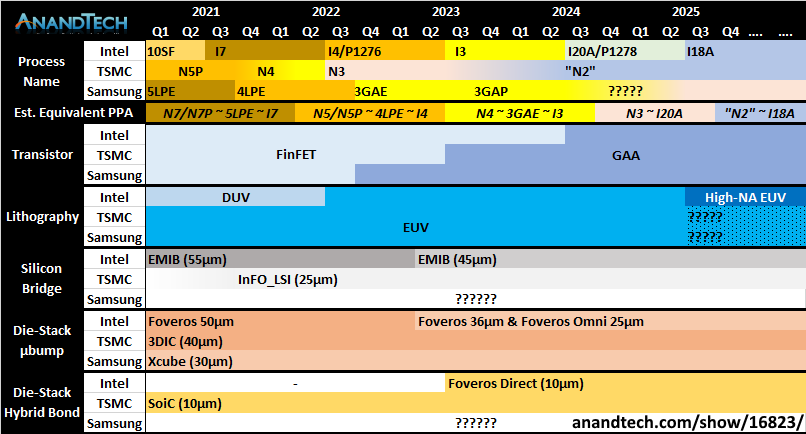Intel's Process Roadmap to 2025: with 4nm, 3nm, 20A and 18A?!
by Dr. Ian Cutress on July 26, 2021 5:00 PM ESTCustomers Customers Customers
As a roadmap announcement today, the focus isn’t so much on the customers but on the technology. Because Intel is moving into a phase where it expects its IFS offerings to compete against the established players, it has to consider its disclosures with respect to both its internal use and any external interest, which is a new concept for the company – at least on this scale compared to its previous foundry efforts.
Intel CEO Pat Gelsinger, in the company’s Q3 financial call last week, was keen to point out that they already have a large hyperscaler customer signed up for their next generation packaging technology, however today there would appear to also be another customer in the mix. Now we assume that Intel’s Foundry Services is talking to 100s of chip companies, big and small, but it doesn’t take much to sign an NDA to start to talk – what will be interesting is when customers start making commitments to using Intel’s facilities, and if any of those are volume orders.
As part of the announcement today, Intel held a little bit back from us, saying that they are saving some of the details specifically for the event that is going on as we publish this piece. All we know is that our draft press release has a big yellow bar that says ‘[customer news]’ on it, right next to Intel’s 20A process node details.
For reference, Intel 20A is a 2024 technology using first generation Gate-All-Around transistors, marketed as RibbonFETs, as well as backside power delivery, marketed as PowerVias. At this time Intel expects to have second/third-generation EMIB available as well as fourth-generation Foveros Direct. So if a customer is already committing to Intel 20A, there’s going to be a lot of potential here.
When the announcement is made, we will update this news article.
To conclude, Intel maintains that these roadmaps will showcase a clear path to process performance leadership* by 2025. It’s a tall order, and the company has to execute better than it has in recent memory - but that’s kind of why the company has rehired a number of former Intel experts and fellows in research, product design, and execution.
*as measured by performance per watt at iso-power
Here's a secondary comparison chart (compared to the one on page one) with all three main foundry offerings listed in each of the main segments that Intel has discussed today.











326 Comments
View All Comments
mode_13h - Tuesday, July 27, 2021 - link
Anyway, the real point is that the first two of those iterations basically don't count. The first was *completely* noncompetitive and the second was *barely* competitive.Usually, when Intel introduces a new node, it's already superior to the existing node, which is something we can't really say until their 3rd gen 10 nm (SF). Granted, if they hadn't refined their 14 nm quite so much, Ice Lake (2nd gen 10 nm) probably would've compared more favorably to it.
AdrianBc - Tuesday, July 27, 2021 - link
I completely agree.TheinsanegamerN - Tuesday, July 27, 2021 - link
So they finally caught up to where they were before 5 years after the product was support to be used for a mass release? At least according to rumors, there's no telling if alder lake will actually be able to do that, let alone sustain such speeds.Skylake was supposed to be 10nm BTW.
Spunjji - Thursday, July 29, 2021 - link
"Skylake was supposed to be 10nm BTW."Based on what information? Are you sure you don't mean Kaby or Coffee Lake? Skylake was only the second architecture on 14nm - the tock to Broadwell's tick (or whichever way around that went).
Spunjji - Thursday, July 29, 2021 - link
TSMC hasn't always been like this. They had a history of delayed, underperforming, or even cancelled nodes - 32nm was a big one, as it screwed up both ATi and Nvidia's plans for a generation and effectively gave Nvidia time to catch up after the Fermi disaster. More recently, AMD had to cancel their 20nm projects because the node sucked, and swallow the resulting financial losses at a time when they couldn't really afford it.I'd say their secret sauce is learning from experiences like that and - as others have said - ploughing funds into R&D rather than resting on their successes.
throAU - Tuesday, July 27, 2021 - link
might be catching up in name but a shame they are still nowhere in terms of processing per watt.shabby - Tuesday, July 27, 2021 - link
Don't worry, pat will rename the watt to intel watt soon. Formula will be watt/2=intel watt = intel in more efficient than amd!29a - Tuesday, July 27, 2021 - link
I can't see that even making them more efficient, a 5600x literally uses 65w max.Oxford Guy - Wednesday, July 28, 2021 - link
Isn’t Apple’s M1 more efficient, as least in some workloads?mode_13h - Thursday, July 29, 2021 - link
Yes, efficiency is where the M1 really excels.